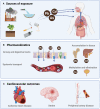Contaminant Metals as Cardiovascular Risk Factors: A Scientific Statement From the American Heart Association
- PMID: 37306302
- PMCID: PMC10356104
- DOI: 10.1161/JAHA.123.029852
Contaminant Metals as Cardiovascular Risk Factors: A Scientific Statement From the American Heart Association
Abstract
Exposure to environmental pollutants is linked to increased risk of cardiovascular disease. Beyond the extensive evidence for particulate air pollution, accumulating evidence supports that exposure to nonessential metals such as lead, cadmium, and arsenic is a significant contributor to cardiovascular disease worldwide. Humans are exposed to metals through air, water, soil, and food and extensive industrial and public use. Contaminant metals interfere with critical intracellular reactions and functions leading to oxidative stress and chronic inflammation that result in endothelial dysfunction, hypertension, epigenetic dysregulation, dyslipidemia, and changes in myocardial excitation and contractile function. Lead, cadmium, and arsenic have been linked to subclinical atherosclerosis, coronary artery stenosis, and calcification as well as to increased risk of ischemic heart disease and stroke, left ventricular hypertrophy and heart failure, and peripheral artery disease. Epidemiological studies show that exposure to lead, cadmium, or arsenic is associated with cardiovascular death mostly attributable to ischemic heart disease. Public health measures reducing metal exposure are associated with reductions in cardiovascular disease death. Populations of color and low socioeconomic means are more commonly exposed to metals and therefore at greater risk of metal-induced cardiovascular disease. Together with strengthening public health measures to prevent metal exposures, development of more sensitive and selective measurement modalities, clinical monitoring of metal exposures, and the development of metal chelation therapies could further diminish the burden of cardiovascular disease attributable to metal exposure.
Keywords: AHA Scientific Statements; arsenic; cadmium; cardiac risk factors; coronary disease; heavy metals; lead; myocardial infarction.
Figures



References
MeSH terms
Substances
LinkOut - more resources
Full Text Sources
Medical

